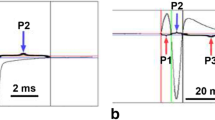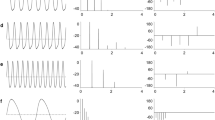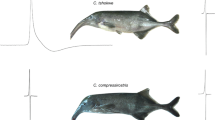Summary
The paper describes the first part of a longitudinal study of the development of electric organ discharge (EOD) in the mormyrid fishPollimyrus isidori. Laboratory bred larvae were continuously monitored for EOD onset in a small glass recording cell fitted with recording electrodes (Fig. 1). Temperature was held at 27 °C+-0.05°.
-
1.
First recognisable EODs were recorded on Day 8 following spawning (Fig. 4). The EOD was about 10 ms in duration in contrast to 50 μs in the adult (Fig. 2). The head positive main phase of the larval EOD soon appears (Fig. 10) and is thus of the opposite polarity to the adult discharge.
-
2.
During the first 6 h following the first EOD the amplitude and discharge patterns changed very rapidly. The EOD of a reference fish was analysed discharge by discharge over this period (Fig. 5). Amplitude increased by over 400% from an initial 50 μV (p-p) recorded potential. Most discharges occurred in trains of up to 14 EODs with relatively constant intra-train intervals of 100–150 ms (Figs. 7, 8, 13).Inter-train intervals decreased very rapidly from minutes to tens of seconds over the first 6 h (Fig. 9). Longer trains tended to occur more often during swimming activity (Fig. 6).
-
3.
The first clear changes in form of discharge occurred between 8 and 10 h post-EOD onset (Fig. 10). Secondary and tertiary discharges at 6 ms and 12 ms intervals from the main EOD commenced during the 12th and 18th h respectively. By 24 h all fish in the peer group (Fig. 11) were producing multiple EODs. At 36 h all these discharges had stopped but were soon replaced by large, secondary EODs (Fig. 14). These were in turn replaced by 8 ms multiples (Fig. 15) for a transitory period and by 70 h all multiple EODs had ceased.
-
4.
Morphological studies show that a primitive larval electric organ is the only generating structure present during the period of larval discharge.
-
5.
Physiological models are proposed to account for the observed discharge pattern variations during the initial developmental period. 12 ms multiple EODs appear to be ‘self-echoing’ -an oscillation of the electrosensory system due to the incomplete establishment of the afferent control system which normally inhibits such feedback.
Similar content being viewed by others
References
Bauer, R.: High electric discharge frequency during aggressive behaviour in a mormyrid fishGnathonemus petersii. Experientia28, 669 (1972)
Bell, C.C., Myers, J.P., Russell, C.J.: Electric organ discharge patterns during dominance related behavioural displays inGnathonemus petersii (Mormyridae). J. comp. Physiol.92, 201–228 (1974)
Bennett, M.V.L., Steinbach, A.B.: Influence of electric organ control system on electrosensory afferent pathways in mormyrids. In: Neurobiology of cerebellar evolution and development (ed. E.R. Llinas), pp. 207–214. Chicago: Amer. Med. Assoc. (1969)
Birkholz, J.: Zufällige Nachzucht beiPetrocephalus bovei. Das Aquarium3, 201–203 (1969)
Birkholz, J.: Nachwuchs beiPetrocephalus bovei. Das Aquarium4, 340–342 (1970)
Daget, J.: Alevins deMormyrus rume. Bull. Soc. Zool. France83, 200–204 (1958)
Dahlgren, U.: Origin of the electric tissue ofGymnarchus niloticus. Dept. Marine Biol., Carnegie Institute, Washington. Papers from the Tortugas Laboratory6 (183) 161–194 (1914)
Denizot, J.P., Kirschbaum, F., Westby, G.W.M., Tsuji, S.: On the larval electric organ of the mormyrid fishPollimyrus isidori. J. Neurocytol., in press (1977)
Heymer, A., Harder, W.: Erstes Auftreten der elektrischen Entladungen bei einem jungen Mormyriden. Naturwissenschaften62, 489 (1975)
Hopkins, C.D.: Electric communication in fish. Amer. Scientist62, 426–437 (1974a)
Hopkins, C.D.: Electric communication: functions in the social behaviour ofEigenmannia virescens. Behaviour50, 270–305 (1974b)
Johnels, A.G.: Notes on fishes from the Gambia river. Ark. Zool.6, 327–411 (1954)
Kirschbaum, F.: Environmental factors control the periodical reproduction of tropical electric fish. Experientia31, 1159–1160 (1975)
Kirschbaum, F.: Electric organ ontogeny: Distinct larval organ precedes the adult organ in weakly electric fish. Naturwissenschaften64, 387–388 (1977a)
Kirschbaum, F.: Ontogeny of larval and adult electric organ in the mormyrid fishPollimyrus isidori. I. Light microscopic studies. In preparation (1977b)
Kirschbaum, F.: Reproduction of the weakly electric fishPollimyrus isidori (Mormyridae) in captivity. In preparation (1977c)
Kirschbaum, F., Denizot, J.P.: Sur la différenciation des électrorécepteurs chezMarcusenius sp. etEigenmannia virescens (Gymnotidés), poissons électriques a faible décharge. C. R. Acad. Sci. Paris281, 419–422 (1975)
Kirschbaum, F., Westby, G.W.M.: Development of the electric discharge in mormyrid and gymnotid fish (Marcusenius sp. andEigenmannia virescens). Experientia31, 1290–1293 (1975)
Kramer, B.: Electric organ discharge interaction during interspecific agonistic behaviour in freely swimming mormyrid fish. I. Comp. Physiol.93, 203–235 (1974)
Russel, C.J., Myers, J.P., Bell, C.C.: The echo response inGnathonemus petersii (Mormyridae). J. comp. Physiol.92, 181–200 (1974)
Srivastava, C.B.L., Szabo, T.: Development of electric organs ofGymnarchus niloticus. I. Origin and histogenesis of electroplates. J. Morphol.138, 375–386 (1972)
Srivastava, C.B.L., Szabo, T.: Development of electric organs ofGymnarchus niloticus. II. Formation of spindles. J. Morphol.140, 461–466 (1973)
Szabo, T.: Development of the electric organ of Mormyridae. Nature188, 760–762 (1960)
Szabo, T.: Rapports ontogénétiques entre l'organe électrique, son innervation et sa commande encéphalique (Mormyrus rume). Z. Zellforsch.55, 200–203 (1961)
Taverne, L.: Note sur la systématique des poissons mormyriformes. Le problème des genresGnathonemus GILL,Marcusenius GILL,Hippopotamyrus PAPPENHEIM,Cyphomyrus MYERS et les nouveaux genresPollimyrus etBrienomyrus. Rev. Zool. Bot. Afr.84, 99–110 (1971)
Westby, G.W.M., Boudinot, M., Kirschbaum, F.: Computer assisted detection of discharge onset and development in larvae of the electric fishEigenmannia virescens. In preparation (1977)
Westby, G.W.M., Kirschbaum, F.: Emergence and development of electric organ discharge in the mormyrid fishPollimyrus isidori. II. The adult discharge. Manuscript (1977)
Zipser, B., Bennett, M.V.L.: Interaction of electrosensory and electromotor signals in the lateral line lobe of a mormyrid fish. J. Neurophysiol.39, 713–721 (1976)
Author information
Authors and Affiliations
Additional information
We would like to thank Dr. Louis Taverne of the Musée Royal de l'Afrique Centrale, Tervuren, Belgium for his expert identification ofPollimyrus isidori. The work was supported in part by fellowships from the Institut National de la Santé et de la Recherche Médicale (INSERM-France) to G.W.M. Westby and from the Deutsche Forschungsgemeinschaft (DFG, West Germany) to F. Kirschbaum.
Rights and permissions
About this article
Cite this article
Westby, G.W.M., Kirschbaum, F. Emergence and development of the electric organ discharge in the mormyrid fish,Pollimyrus isidori . J. Comp. Physiol. 122, 251–271 (1977). https://doi.org/10.1007/BF00611894
Received:
Issue Date:
DOI: https://doi.org/10.1007/BF00611894




